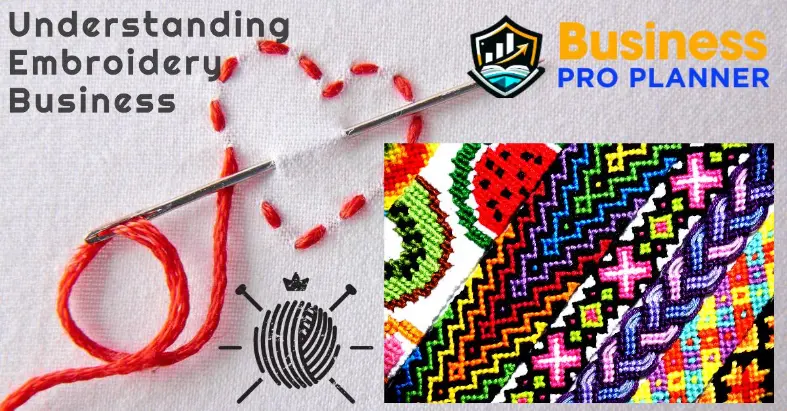Embroidery allows creative entrepreneurs to turn their artistic talent into a rewarding business. Embroidery businesses have been providing personalized, customized products for decades. With the ability to design unique patterns and logos onto various fabrics, entrepreneurs skilled in embroidery have an opportunity to start an embroidery business.
Whether as a small home-based venture or a larger commercial operation, those interested in the field can utilize their creative talents while being their boss. Starting an embroidery business allows one to craft memorable products cherished by customers for years to come. You can start a successful embroidery business doing what you love with proper planning.
Here is a detailed guide on how to start an embroidery business.
Key Takeaways
- Do market research to understand customer needs and demand
- Start small and build your skills with a home-based embroidery machine
- Offer custom apparel, uniforms, gifts, and accessories for businesses and individuals
- Develop a website and business plan to attract and convert customers
- Outsource digitizing and focus on quality embroidery, customer service, and sales
Understanding Embroidery Business

Current Size and Future Outlook
The embroidery industry in the United States is projected to reach $1.3 billion in revenue by 2024, reflecting a steady compound annual growth rate of 3% over the next two years according to IBISWorld forecasts.
There are approximately 4,500 embroidery businesses currently operating, though the market remains highly fragmented with no dominant players. The top 50 businesses account for around 30% of industry share.
California leads with the most embroidery establishments, followed by Texas, Florida, New York, and Illinois. The primary growth drivers will be the rising demand for customized and personalized apparel and accessories. Consumers are increasingly seeking unique embroidery designs over mass-produced goods.
This allows small startups to capitalize on catering to niche markets both locally and online. Profit margins also remain higher compared to other manufacturing ventures, making the embroidery business attractive for entrepreneurs.
While the pandemic impacted short-term gains, the reopening of events, travel, and gatherings will bolster sales. The home embroidery boom during lockdowns also expanded interest and provided a wider customer base.
Digital integration will be key, with businesses needing e-commerce sites and social media alongside traditional retail presence. However, the core value lies in preserving the artistic craft while leveraging technology.
Overall, the industry outlook remains positive for 2024, aided by low barriers to entry, a robust grassroots community, and shifting buyer preferences for unique, customized textile creations. Both hobbyists expanding into commercial embroidery businesses as well as veteran artisans have opportunities to grow.
Notable Trends and Obstacles for New Businesses
Some notable trends shaping the embroidery business include:
- Rising demand for digitization, specialty niche markets, and incorporating modern design elements into traditional handwork.
- Customers increasingly expect digitized files for embroidered goods, driving businesses to invest in advanced software and training. Many embroiderers are targeting specific niches like schools, sports teams, or hospitality businesses to stand out.
- Blending digital design aspects into classic embroidery techniques is also popular, for instance, using bold colors and gradients. However, the highly manual production process poses challenges in scaling up and maintaining profit margins.
- Long production times and reliance on specialty skills also remain hurdles. Choosing the right equipment and managing operating costs are crucial for new embroidery.
Realistic Costs for an Embroidery Startup
- Embroidery Machine: $2,000 to $15,000
- Digitizing Software: $200 to $3,500 one-time cost
- Supplies: Backing, stabilizer, etc. $500 to $2,000
- Tools and Accessories: $500 to $2,000
- Inventory/Fabric: Variable, can start with $1,000
- Marketing Expenses: $500 to $5,000
- Retail Space: $1,000 to $4,000 monthly
- Many start as home-based businesses to reduce costs
- Small business loans or personal savings provide capital
Income Potential for Embroidery Entrepreneurs
The earning potential depends significantly on your business model and pricing strategy, such as:
- Part-time ventures generate $10,000 – $50,000 annual income initially
- Seasoned full-time embroiderers earn $50,000 – $100,000+ with higher prices and more business clients
- Large shops with multiple machines and employees see $250,000+ in revenue
- Profitability depends on pricing strategy, overhead costs, inventory, marketing reach
- Building clientele is key for high earnings
Location, overhead costs, custom work versus bulk orders, inventory, and marketing impact your profit margins. Building a reputation for quality and expanding your client base is key to high earnings.
Key Barriers Faced By New Embroidery Businesses
The embroidery business has relatively low barriers to entry compared to high-cost manufacturing ventures. Still, there are some challenges new embroiderers face:
- Developing expertise in digitizing and machine use involves a steep learning curve. Years of practice are needed to master techniques.
- Purchasing commercial-grade embroidery machines requires a significant upfront investment. Budget options may compromise on quality and efficiency.
- Managing operating costs like inventory, supplies, and production overhead can be daunting early on.
- Becoming proficient in digitizing software takes both artistic skill and technical know-how.
- Building an audience and attracting high-value clients takes considerable effort and marketing.
- Producing complex multi-color designs is time-intensive and demands advanced skills.
However, starting small by providing simple designs, sub-contracting overflow work, and outsourcing digitizing can help manage some barriers. Taking on customized projects where clients provide the base materials also has lower inventory requirements. Overall, an agile business model can overcome many entry hurdles.
Pros and Cons of Embroidery Business
Pros:
- Express your creativity through an artistic medium and see your designs come to life.
- Gain the personal fulfillment of running your own business.
- Flexible and portable – work from home or a small retail studio.
- The low overhead compared to other manufacturing startups.
- Ability to differentiate through specialized embroidered products.
- Services like digitizing and custom designs provide multiple income streams.
- Produce high-value goods by embellishing everyday items like apparel and accessories.
- Small startup costs and ability to begin as a home-based business.
- The crafty nature of the work allows creative fulfillment.
Cons
- Long hours are required, especially when managing embroidery machines.
- Work is very hands-on and process-driven, requiring patience.
- Designing expertise and technical digitizing skills take years to acquire.
- Manual systems make scaling up production challenging.
- Limited ability to compete purely on price; must focus on quality and uniqueness.
- Need to constantly market and expand clientele to drive sales.
- Easy for beginners to make mistakes in designs or damaged materials.
- Digitizing software and equipment costs can be prohibitive initially.
By weighing these pros and cons, you can determine if starting an embroidery business aligns with your goals, skills, and resources. With passion and perseverance, the rewards can outweigh the challenges.
10 Key Steps to Start an Embroider Business

Step 1: Conduct Thorough Market Research and Create a Business Plan
Before diving into launching your embroidery business, it is crucial to understand your target market and craft a detailed business plan.
Analyze the Market:
- Research the embroidery industry trends and growth opportunities in your area.
- Identify your ideal customer profile – age, income level, interests, etc.
- Study your competitors – their pricing, products, marketing, etc.
- Evaluate the demand for different types of embroidered goods like apparel, gifts, and home decor.
Create a Business Plan:
A business plan is an essential tool to guide your embroidery business. Include details on:
- Business Description – services and products offered
- Startup Costs – equipment, supplies, licensing, etc.
- Sales and income projections
- Marketing strategy
- Operational Plan – studio setup, equipment, software, etc.
- Financial Plan – investment requirements, cash flow projections
Step 2: Obtain Necessary Licenses and Permits
Depending on where you plan to establish your embroidery studio, you may need:
- Business licenses from state/local agencies
- Sales tax ID for collecting and remitting sales taxes
- Zoning permits if working from a commercial location
Additionally, you may need a resale certificate or wholesale license to buy supplies and materials from wholesalers.
Step 3: Invest in Quality Embroidery Equipment and Supplies
The startup costs for an embroidery business primarily include investing in equipment and supplies such as:
Essential Equipment:
- Commercial Embroidery Machine – single-head or multi-head
- Digitizing Software like Wilcom, Pulse, and Forte to create designs
- Computer with plenty of storage space
- Backing and stabilizer to hold the fabric taut
Other Equipment:
- Storage shelves and organizational tools
- Embroidery hoops in assorted sizes
- Scissors, needles, and other sewing supplies
Choose equipment wisely based on your budget, business goals, and production needs. Investing in quality tools ensures efficiency and reliability.
Step 4: Develop Your Embroidery Skills and Build a Portfolio
Learning the ins and outs of machine embroidery and digitizing takes extensive practice. Some tips:
- Take classes on using embroidery machines and digitizing software.
- Start with basic designs using 2-4 thread colors to hone your skills.
- Practice on various fabric types like cotton, denim, leather etc.
- Experiment with special techniques like applique, and 3D embroidery.
- Build a portfolio of sample designs to showcase your work.
Additionally, learned skills like image editing and art to digitize custom designs. Developing your expertise will take time but is essential for success.
Step 5: Create a Brand Identity and Promotional Materials
Creating professional branding assets gives your embroidery business an identity to connect with customers.
- Pick a unique and catchy business name.
- Design a logo that represents your brand.
- Have business cards, labels, and tags designed.
- Create email templates, letterheads, and brochures.
- Set up social media business profiles.
Establishing branding creates cohesion across your website, ads, packaging, and other assets.
Step 6: Market Your Embroidery Business Extensively Both Online and Offline
Implementing marketing strategies tailored to your audience is key to attracting customers.
Online Marketing:
- Launch a user-friendly website showcasing your designs.
- Promote your business on social media platforms.
- Run Google and Facebook ads.
- List your products on e-commerce sites like Etsy.
- Offer promotions and email newsletters.
Offline Marketing:
- Network with local businesses and offer custom embroidery.
- Participate in craft fairs, exhibitions, and pop-up events.
- Distribute flyers and business cards in your neighborhood.
- Run print ads in local newspapers and Yellow Pages.
Step 7: Offer Customized and Unique Embroidery Designs
One of the best ways to attract customers is by offering customized embroidery services.
- Allow clients to personalize apparel and accessories.
- Digitize designs based on the client’s requests and ideas.
- Create trendy but unique designs that stand out.
- Cater to specific niches like schools, teams, and businesses.
Providing an exceptional customer experience will help generate word-of-mouth referrals.
Step 8: Price Your Products and Services Competitively
Pricing is important for the profitability of your business. Consider these factors:
- Labor Costs – account for time spent digitizing and embroidering.
- Material Expenses – fabric, threads, stabilizers used.
- Overhead costs of running your business.
- Competitor pricing for similar products.
- The perceived value of your products in customers’ eyes.
Also, offer package deals and discounts to appeal to more buyers.
Step 9: Focus on Excellent Customer Service and Communication
Running a customer-centric business leads to repeat purchases and growth. Some tips:
- Communicate your services, policies, and delivery timelines.
- Guide customers patiently through the customization process.
- Deliver orders professionally and conveniently.
- Follow up with customers for feedback after order completion.
- Offer alterations and fix issues promptly.
Custom embroidery projects often require collaboration. Maintain open communication channels to ensure a smooth process.
Step 10: Manage Finances Diligently
Careful financial planning is necessary for profitability.
- Track income and expenses closely. Break down costs per product/service.
- Maintain proper bookkeeping records.
- Calculate profit margins accurately for pricing decisions.
- Manage inventory well – don’t overstock or understock supplies.
- Invest surplus funds back into the business wisely.

Conclusion
With dedication and skill, you can create a thriving embroidery business. Conduct in-depth planning, invest in quality equipment, master necessary techniques, implement marketing tactics, provide stellar service, and manage finances prudently. By differentiating with unique offerings and building a loyal customer base, you can establish a successful and rewarding embroidery business.


1 thought on “How to Start an Embroidery Business: An In-Depth Guide!”